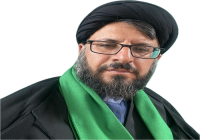Digression: Jews of Medina
One may wonder what brought those Jews to Medina to live among people whom they regarded as their inferior, polytheist pagans who regarded as profession other than trade to be beneath their status. There are two theories. One says that those Jews were motivated by the desire to be the first to believe in the new Arabian Prophet whose name was written in their religious books and whose mission was about to start, so they made a mass immigration to Medina.
Their high rabbis had told them that Medina would be the place where the new Prophet, Muhammad (ص), would be preaching the divine message. This view is supported by verses 40 – 103 of Surat al-Baqara (Chapter of the Cow, i.e. Ch. 2) which repeatedly admonishes the Israelites and strongly rebukes them for seeing the truth but turning away from it. According to this theory, those Jews with religious fervor had come from Jerusalem in particular and Greater Syria (Sham) in particular.
The other theory seeks an explanation from the historic events that took place in southern Arabia, particularly Yemen, concluding that those Jews had migrated from there seeking religious freedom and better economic conditions. This is how advocates of this theory reason:
The immigration of the majority of Jews into Yemen from abroad appears to have taken place about the beginning of the 2nd century A.D. But the province is mentioned neither by Josephus, better known as Yoseph ben (ibn, i.e. son of) Mattithyahu (37 – cir. 100 A.D.), a Romano-Jewish historian and hagiographer of priestly and royal ancestry, nor by the main books of the Jewish oral law, namely the Mishnah and Talmud.
According to some sources, the Jews of Yemen enjoyed prosperity until the 6th century A.D. The Himyarite King, Abu-Karib Asad Toban, converted to Judaism at the end of the 5th century, while laying siege to Medina. It is likely some of his soldiers preferred to stay there for economic and perhaps other reasons. His army had marched north to battle the Aksumites who had been fighting for control of Yemen for a hundred years. The Aksumites were only expelled from the region when the newly Jewish king rallied the Jews from all over Arabia, together with pagan allies. But this victory was short-lived.
In 518 A.D., the kingdom of Yemen was taken over by Zar’a Yousuf, who was of “royal descent” but was not the son of his predecessor, Ma'di Karib Ya’fur. Yousuf converted to Judaism and instigated wars to drive the Aksumite Ethiopians from Arabia. Zar'a Yousuf is chiefly known by his cognomen “Thu Nuwas”, in reference to his "curly hair." The Jewish rule lasted till 525 A.D., only 85 years before the inception of the Islamic Prophetic mission.
Some historians, however, date it later, to 530, when Christians from the Aksumite Kingdom of Ethiopia defeated and killed Thu Nuwas, taking power in Yemen. According to a number of medieval historians, Thu Nuwas announced that he would persecute the Christians living in his kingdom, mostly in Najran, because Christian states had persecuted his fellow co-religionists (the Jews) in their realms. This persecution, which took place in the year 524 A.D., is blamed on one Dimnon in Najran, that is modern al-Ukhdud area of Saudi Arabia.
Any reader of the Holy Qur’an must have come across verse 4 of Surat al-Buruj (Chapter 85) of the Holy Qur’an which refers to أَصْحَابُ الأُخْدُودِ, fellows of the Ukhdud, which is imprecisely translated as “the ditch self-destructed” in some English translations of the Holy Qur’an. To the author of this book, who speaks Arabis as his mother tongue, my dear reader, “the ditch self-destructed” does not make much sense at all.
Actually, this “ukhdud” was a long ditch filled with firewood. It was lit and the believers were thrown into it if they refused to abandon their faith. Some ran away from this inferno, which may remind one of a similar situation which took place with Prophet Ibrahim (Abraham) at the hands of Nimrud of 13th Century B.C. Assyria. The survivors, most likely Christians and Jews, fled up north in the direction of Medina which they made home. The Almighty in 85:4 condemns this massacre in the strongest of terms, and Christians and Jews ought to appreciate this fact.
According to some sources, after seizing the throne of the Himyarites, in 518 or 523 A.D., Thu Nuwas attacked the Aksumite (mainly Christian) garrison at Zafar, capturing them and burning their churches. He then moved against Najran, a Christian and Aksumite stronghold. After accepting the city's capitulation, he massacred those inhabitants who would not renounce Christianity in this ukhdud incident. Estimates of the death toll from this event range up to 20,000 in some sources. So, believers in God, Christians and Jews, had reasons to go somewhere else where they would practice their religion freely while enjoying better business opportunities among Arabs who, at the time, were mostly nomads.
http://www.al-islam.org/fatima-the-daughter-of-muhammad-a-brief-biography-yasin-al-jibouri/










